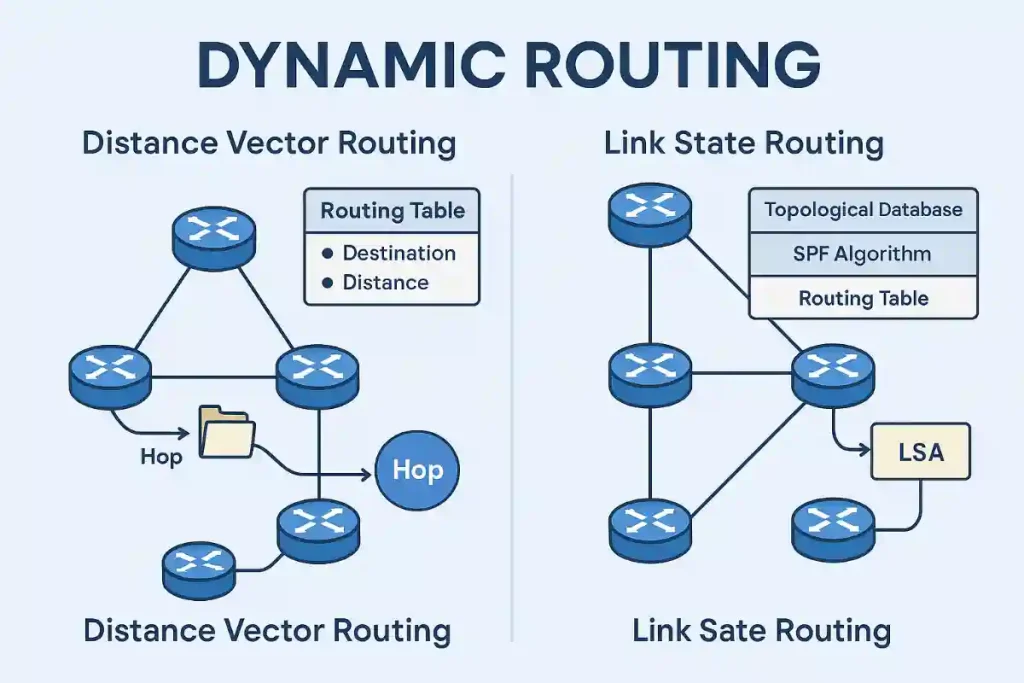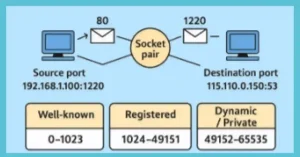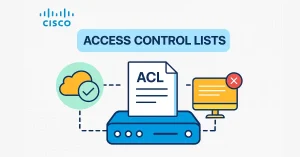Dynamic routing is a networking technique that provides optimal data routing. The network administrators and engineers configure a dynamic routing protocol on the network interfaces.
The protocol running on the router learns about other routers automatically and also dynamically exchanges routing information with other routers. Dynamic routing protocols perform several activities, including network discovery and maintaining routing tables.
Unlike static routing, a dynamic routing protocol automatically selects the best route to put into the routing table as well, and the network changes update the routing table accordingly:
- EIGRP and EIGRP for IPv6– Enhanced Interior Gateway Routing Protocol
- OSPF– Open Shortest Path First for IPv4 and OSPFv3 for IPv6
- IS–IS–Intermediate System-to-Intermediate System
- RIP and RIPng(RIP for Next Generation for IPv6)– Routing Information Protocol
All the dynamic routing protocols use routing algorithms. There are two types of routing algorithms. Routing algorithms are the backbone of dynamic routing protocols, enabling routers to determine the best paths for data. Distance Vector and Link-State algorithms form the core types, but hybrid protocols like EIGRP combine features of both for enhanced performance. This section introduces their significance for CCNA and CCNP students.
- Distance Vector Routing algorithms
- Link-state routing algorithms
Distance Vector Routing algorithms
A distance-vector routing protocol informs its neighbors about topology changes periodically. It is a simple protocol used in packet-switched networks that uses distance to decide the best packet forwarding path.
It is also known as the Bellman-Ford algorithm, where all routers maintain a Distance Vector table containing the distance between the router itself and all other possible destinations and the way to the destination.
A hop is the journey a packet takes from one router to the next en route to its destination. RIP, a Distance Vector protocol, uses hop count as its metric, with a maximum limit of 15 hops. Each Router configured distance vector algorithm transmits its distance as well as the vector to all neighbors. Other routers using the distance vector protocol receive and save the most recent information from each of their neighbors.
Distance Vector protocols select the best path by minimizing the hop count to each destination. The Routing Information Protocol(RIP) uses the Distance Vector Technique. The Bellman-Ford algorithm powers Distance Vector protocols by calculating paths based on hop count. While simple, it can lead to routing loops—where packets cycle between routers—mitigated by techniques like split horizon. Beyond RIP, EIGRP offers faster convergence and scalability, making it a key protocol for CCNP students. A comparison table of RIP vs. EIGRP (metrics, convergence, use cases) will clarify their differences. Using the distance vector, each router advertises its routing table to its adjacent neighbors. Each advertisement has the following information:
Distance – The hop count for the router
Vector – The direction where the route is located
The receiving router does not generate acknowledgments, so it reduces the overhead of routing protocol traffic. The router selects the best path with the lowest cost to the possible destination for the packet.
Routers add the selected route to their routing tables and propagate it to the neighbor using hop-to-hop until all routers spread the information to the entire network.
Links State Routing Algorithms
The Link-State keeps a complete record and roadmap of the router running the link-state routing protocol in the network. Each router running link-state protocol shares information about the router to its directly connected interfaces and the state of all interfaces configured with the link-state protocol. Link-state routing constantly attempts to keep a full network topology by updating itself incrementally when a change happens in the network.
In OSPF, routers flood Link-State Advertisements (LSAs) as multicast messages to all routers within their area, not the entire network, maintaining efficiency. After starting up, the router sends its first link-state information to its neighbors.
So, this reduces the network load by only sending updates to its link information. The Open Shortest Path First (OSPF) is the most important type of Link-State routing protocol. OSPF’s hierarchical structure divides networks into areas, managed by Area Border Routers (ABRs), reducing overhead in large networks. The SPF (Dijkstra’s) algorithm computes the shortest path by analyzing the topological database, a process CCNP students must master. This section explains these concepts with examples. The important terms of using link-state are as follows.
Link-state advertisements (LSAs) –These are updates on the link status, so routers send LSAs when a link changes from its current state. It is a small packet of routing information flooded out to all routers in their area or zone.
Topological database – A topological database is a set of information gathered from the exchange of several LSAs between routers, which describe the network topology in great detail. All routers in the network store the received LSA packets in the link-state database (LSDB).
SPF algorithm – The shortest path first (SPF) algorithm, also known as Dijkstra’s algorithm, performs the calculation of the database and builds the SPF tree. All routers in an area run this algorithm in parallel, storing the results in their topological databases.
Routing tables – A list of the known destinations and interfaces.
Dynamic Routing Protocol Selection
Choosing a protocol depends on network size, convergence speed, and scalability. RIP suits small networks, while OSPF and EIGRP excel in larger, complex setups.
Configuration Guides
- RIP:
router rip,network 192.168.1.0,version 2 - OSPF:
router ospf 1,network 192.168.1.0 0.0.0.255 area 0 - EIGRP: r
outer eigrp 100,network 192.168.1.0
Troubleshooting Tips
Common issues include routing loops (RIP) and misconfigured areas (OSPF). Use show ip route and debug ip ospf adj to diagnose.
FAQs
What is the difference between static and dynamic routing?
Static routing requires manual configuration, while dynamic routing uses protocols like RIP and OSPF to adapt automatically to network changes.
What are the advantages of dynamic routing over static routing?
Dynamic routing scales better, reduces manual effort, and updates routes dynamically as the network changes.
How does Distance Vector routing work?
Distance Vector protocols, like RIP, use hop count to determine paths and share routing tables with neighbors periodically.
What is the role of the SPF algorithm in Link-State routing?
The SPF algorithm (Dijkstra’s) calculates the shortest path to each destination using the topological database.
Which dynamic routing protocol is best for large networks?
OSPF and EIGRP are ideal for large networks due to their scalability and fast convergence, unlike RIP.





